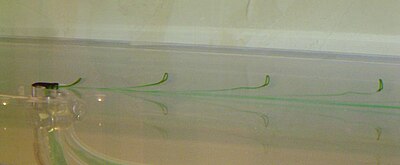Seeding (fluid dynamics)


Seeding a material is a concept used in fluid dynamics to describe the act of introducing specific particulates or other foreign substances into a stream of fluid being evaluated. An altered fluid will be described as having a seeded flow.[1]
Details
This section needs expansion. You can help by adding to it. (September 2015) |
These particulates are generally small enough to be carried by the fluid but large enough to be picked up using a flow visualization technique, such as particle image velocimetry (PIV). In reference to aerodynamic testing, such as wind tunnel testing, water tunnel testing, or any other test investigating the flow of a fluid which may be invisible to the naked eye, seeding a flow is often the only way to take visual measurements. Simple examples of a seeded flow include the introduction of smoke into a low speed wind tunnel to see the general path of the air, or injecting colored dye into a water tunnel to see secondary flow structures such as hairpin vortices.[citation needed]
As stated in The Handbook of Fluid Dynamics, an ideal seeding particle should have uniform properties such that its density is the same as the fluid that it's added to.[1]
See also
References
- ^ a b Johnson, Richard W. (1998). The Handbook of Fluid Dynamics. Springer Science & Business Media. ISBN 9783540646129.
